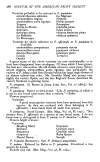accepted name (2005):
cultivar
Stern (1946)
P.humilis var. villosa forma fimbriata (Sabine) F. C. Stern forma nova flore plena distincta.
Syn. P.paradoxa var. fimbriata Sabine in Trans. Hort. Soc. London, 2, 276 (1817); Anderson in Trans. Linn. Soc. London, 12, 28o (1818) ; Sweet, Brit. Flow. Gard. 1, t. 19 (1823) ; Journ. Jard. 1841, P.252, c. ic.; Hort. Univ. 3,104, c. ic. (1842), 5, 175, c. ic. (1844).
Paeonia paradoxa
Diese Wildart wird heute ziemlich einhellig als Paeonia officinalis subsp. huthii Soldano [vormals Paeonia villosa Desfontaines bzw als illegtimes Synonym Paeonia officinalis subsp. villosa (Huth) Cullen & Heywood] bezeichnet, ist also eine Unterart von Paeonia officinalis. Entprechend werden die Kulturformen hier eingeordnet. Die Problematik der fehlenden Abgrenzbarkeit zu Paeonia peregrina dürfte hier nicht in derselben Schärfe bestehen wie bei den von Saunders Zeitgenossen als Officinalis-Sorten bezeichneten. Allerdings – im Prinzip sind alle verschwunden in den Jahren seit Publikation des Buches von Boyd.
A.P. Saunders: PEONY SPECIES (Other than albiflora and moutan) in: Peonies, The Manual of the American Peony Society, edited by James Boyd © 1928 American Peony Society:
P. officinalis. Southern Europe. This species has been cultivated in European gardens for centuries, and has given rise to a number of. brilliant and lovely varieties. There is much confusion regarding those which are to be traced back to P. officinalis and those derived from P. paradoxa.
Vilmorin ("Fleurs de Pleine Terre") separates two groups under these two specific names; and he states that those derived from P. paradoxa are easily distinguished by the glaucescence (bluish greenness) of the foliage. Unfortunately, Vilmorin does not include in nis list by any means all of the varieties which are, or have been, in commerce.
Since these forms when offered in nurserymen's lists are usually grouped all together under P. officinalis, I have listed them all here, making a separate group of those which, according to Vilmorin, should be referred to P. paradoxa.
A further complication arises from the fact that several varieties have been produced from P. lobata. This is itself to be considered as a variety of P. officinalis, and it is not always possible in the case of named varieties to say whether they should be referred to P. lobata or to the broader species P. officinalis.
286
MANUAL OF THE AMERICAN PEONY SOCIETY
Varieties probably to be referred to P. paradoxa:
amaranthescens sphaerica
anemoneflora aurea ligulata
anemoneflora elegans
Erigone
Etoile de Pluton
fimbriata
fimbriata plena
La Brillante
La Mauresque
La Negresse
Nemesis
Noble pourpre
Proserpine
pulchella plena
rubra striata
violacea fimbriata plena
violacea sphaerica
Varieties for which reference to P. officinalis or P. paradoxa is doubtful:
anemoneflora pompadoura
pomponia striata
anemoneflora rosea
pomponia violacea
daurica flore-pleno
rubescens plena
Lucida
Tartarica
Ourika

